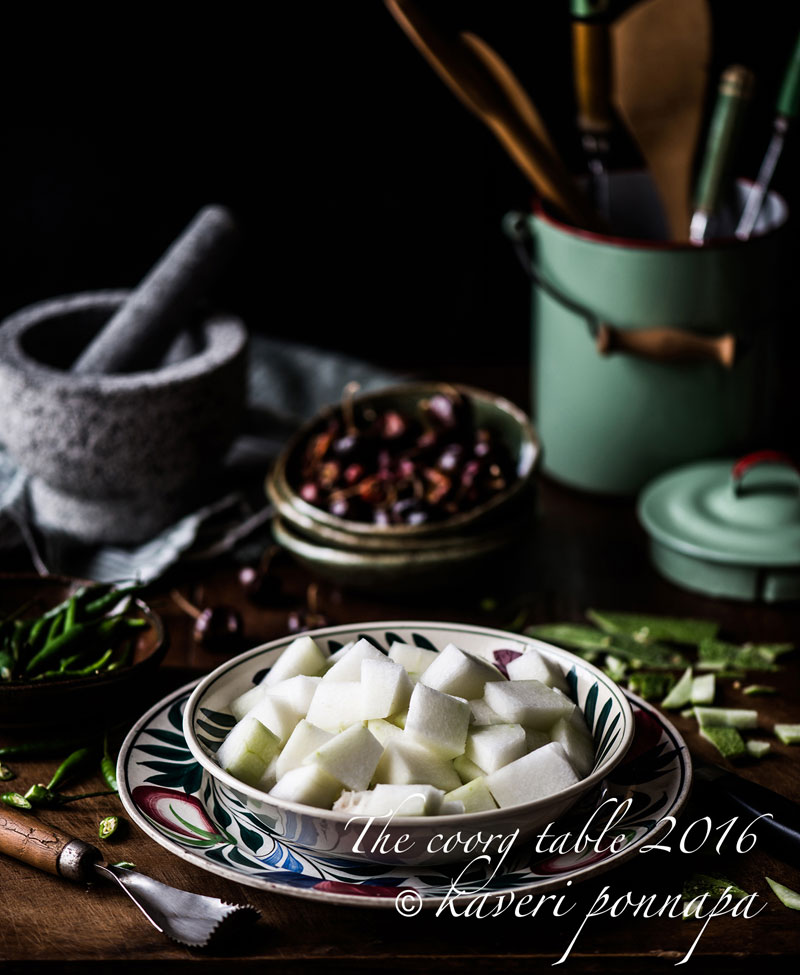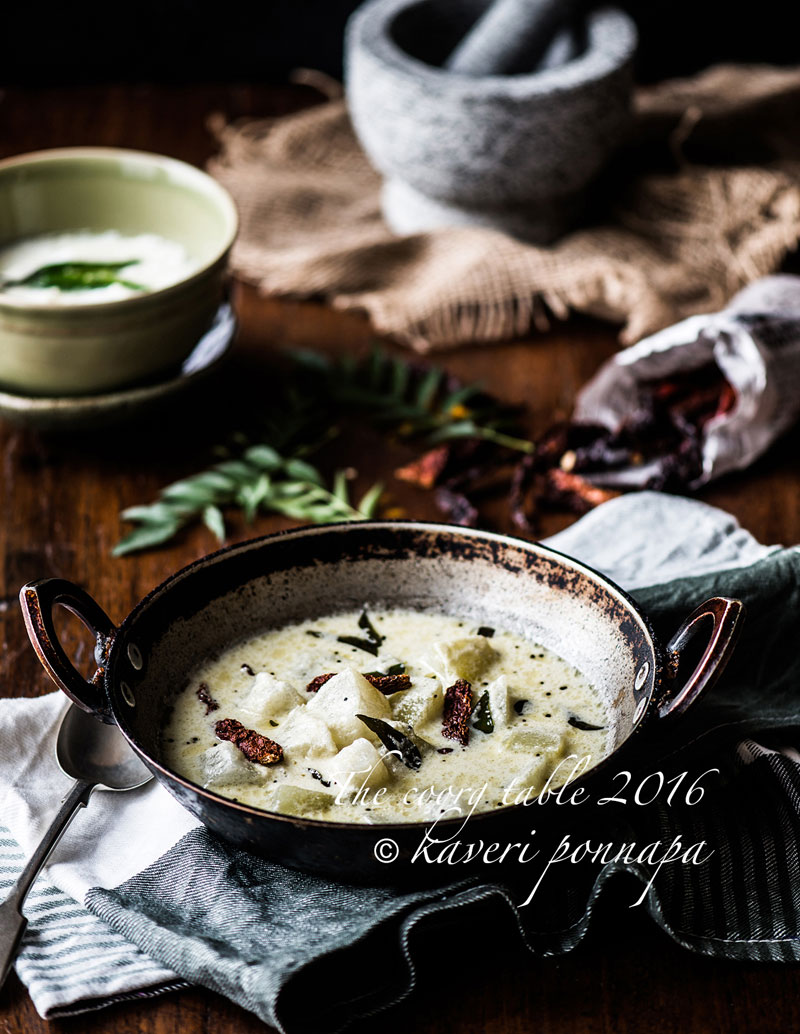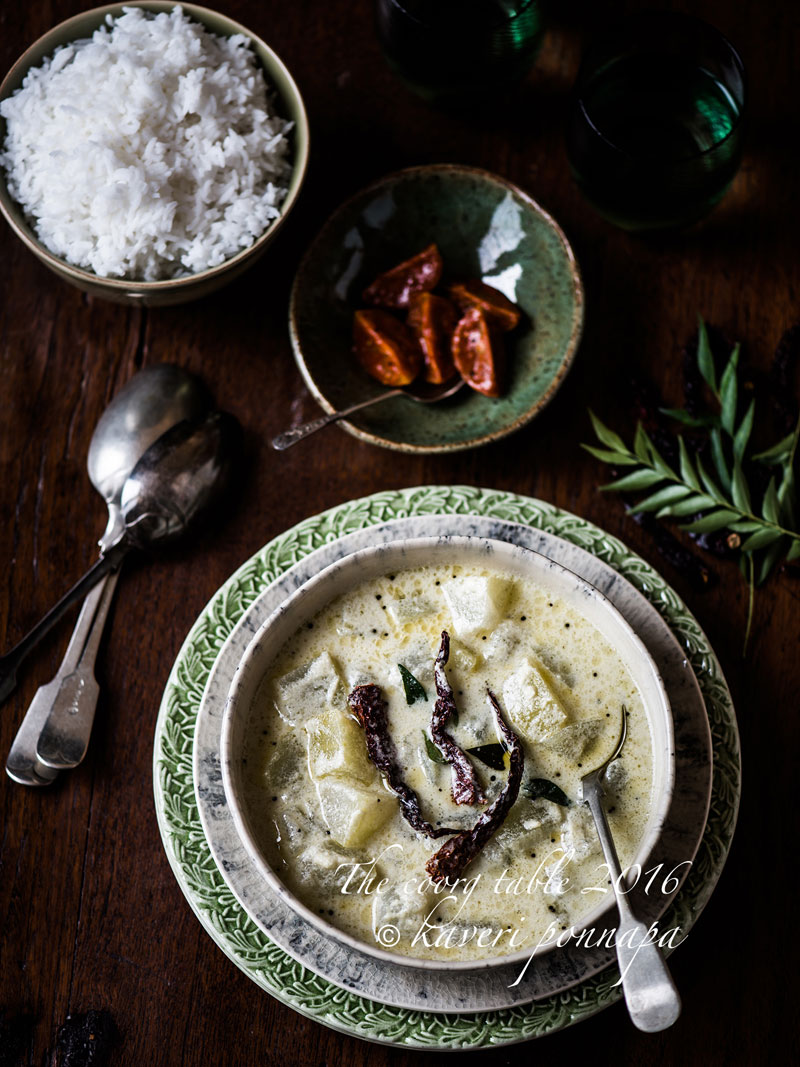Huge, impassive, its inscrutable, waxy green surface chalky, like a folk artist who has been too free with the face powder, the ash gourd is a strange and fascinating product of our vegetable patches. It grows silently in kitchen gardens, the favourite choice for plots in rice fields dedicated to growing gourds, squashes, beans and all manner of sustaining and filling vegetables between harvests, vegetables that can be stored through the long, lean months when the more delicate, prized but ephemeral shoots and leaves have exhausted their brief blaze of frenzied creativity. When all the attention grabbing mushrooms and bamboo shoots have gone, the ash gourd lingers on, patiently. It grows steadily, storing up an extraordinary range of valuable nutrients in its generous white flesh, its young, fuzzy skin replaced by the familiar, waxy surface, pale with an ashy coating, waiting amiably to be called to the table. The confusion over its name continues: ash gourd; ash pumpkin; winter melon; so I’ll just call it by its familiar domestic name – boodi kumbala. 
We used to see boodi kumbalas growing all across Coorg; we still see them, tumbling over each other at pop-up roadside vegetable stalls –but somehow, I get the feeling they are not as favoured as they once were. They would make their way from the kitchen garden to the table in a thin, delicate curry. Strips of waxy green would lie scattered on the kitchen table, bits of white flesh still attached, a testimony to the violent struggle that had just taken place between an ancient kitchen knife and the thick, tough skin.
The flesh was cut into large chunks and cooked very simply with a minimum of supporting spices to become translucent, almost buttery, bathed in a curry thickened with a scant cupful of curd. I have always loved boodi kumbala mor curry. It was a slightly unusual preference when there were so many other, much richer, dishes on the table, particularly the meats. (Read more at The Reluctant Vegetarians) But I looked forward to it, the slight tang that offset the mildness of the ash gourd, the hidden pungency of mustard and green chillies. It could sometimes be a real disappointment though: when it was slightly overgrown tough fibres webbed the flesh, ruining the softness of the cubes and the afternoon meal. But most often, everything was just right: tender flesh in a curry with tranquil, earthy flavours of its own, mashed into rice and eaten without a fuss. It was a memorable meal in its sheer simplicity. Perhaps a slice of lime pickle as an accompaniment, but nothing else was needed.
The ash gourd has a monumental, silent presence that always sends me off on old journeys deep into the heart of the countryside. It lurks in neglected corners or attics of homes, usually on a length of dusty hessian. A timeless Coorg riddle asks us to guess at this: “a grey old man sits in our attic” – the answer, of course, is the ash gourd, which skulks (in a slightly sinister manner, one might just say) in everyone’s attic. Sometimes you spot it sitting alone on a bench at a bus stop, unattended, with an air of quiet dignity about it, as its farmer transports it to the weekly market. You often pass it on a beautiful, ancient country lane overhung with trees that skirts rice fields, carried on the shoulders or heads of men and women staggering under the weight, on their way to a local shrine with offerings from their fields. Many times I have sat with larger than life ash gourds beside me for company on the platforms that run around the courtyards of Coorg shrines, huge ashy orbs brought by grateful families as thanksgiving offerings from their freshly harvested fields, along with sacks of rice. We would then eat that rice and the very same ash gourd curry together for lunch off shiny green banana leaves, crowds of strangers enjoying a meal cooked with produce we had shared, before we all went home, and somehow everything seemed as it should be.
Has it gone out of fashion to have boodi kumbala mor curry on the table? I’m not sure, but I don’t seem to see it quite so often as I used to. This is a curry I have thought about many times, loving it, but not quite sure how to make it, not sure how to prevent the flesh from dissolving into a mush that works fine for a halwa and a jam, but not for this curry. It took many queries to older friends and some kitchen trials before I was able to replicate the taste I remembered so well –slightly frugal and yet lush, green spice under the mildness of the succulent cubes, satisfying and nourishing. Eating this curry has always been a soothing, undemanding experience, so I was only a little surprised to read that ash gourd is associated with cooling and calming properties in systems of natural medicine, highly valued for its curative powers.
ince then I have cooked it into dals, curries, soups and delicious broths. There is a wonderful halwa and a chunky jam that you spread thickly on slices of bread or eat with akki ottis and homemade butter –but more about those two later. Boodi kumbala lends itself gracefully to all of these. I feel we have not even begun to explore the possibilities of this generous giant. It also makes you think of the many dozens of marvellous native vegetables, leaves and fruits that we have stopped growing, and have forgotten in our kitchens, of what we might be missing out on what’s available, quite literally, right in our backyards.
Photo Credits: Nithin Sagi
All Food Styling: Kaveri Ponnapa
Please look out for the recipe in my upcoming cookbook
Thank you for visiting this page. If you read something that you enjoy, or see an image that you like, please take a moment to write a response. Do look out for the recipes of all the food featured here in my upcoming cookbook.





Looking forward to the book, especially the mutton cutlet! Was feeling really nostalgic for my Thai’s boodi kumbla halwa today and your blog popped up when I was looking for a recipe. The mor curry that my mother makes is also sublime!
Hello Shabari, thank you for writing-it’s still a bit of a wait for the book, but I do hope it will be worth it. I love boodi kumbala halwa too, in fact, most things made from it. Maybe it’s time to write a post about the halwa. Do keep reading.Best wishes. Kaveri
Waiting for your upcoming cook book. Could you please let me know by when it woul be published?
Hello Manasa, thank you very much for your interest. I would love to give you a date, but don’t know for sure, right now. But it is a work in progress, so do keep reading these pages, I will post as soon as I know. Best wishes. Kaveri
This mor curry goes well with kaipake curry with beans kaalu.lovely recipe coorg table.the pic too looks delicious
Thank you very much for sharing, Rekha, I’m going to try out this combination, I’m sure it is very good. Warm wishes.Kaveri
I always look forward to your posts ..it takes me back to memories…other day made boodi kumbala jam kids loved it…you make it look so effortless n delicious
Thank you very much, Savitha. I can imagine how delicious your boodi kumbala jam tasted, and how much the kids enjoyed it. That was one of real favourites when I was a child, my grandmother made a wonderful version. I also love the halwa. Do keep reading! Warm wishes.Kaveri
i was just thinking of this yesterday! Thank you so much :)..your post always makes me homesick (but in a good way!) On my to do list! I need not bother my mother for the recipes too..The recipes are so authentic and just the way she makes it
Hello Ganga, welcome to The Coorg Table! It makes me feel great to hear that my recipes remind you of your mother’s cooking and yes,it’s nice to be reminded of home through our favourite foods. I’m delighted that this page does all these things for you-please keep reading, and hopefully I should have more recipes and stories for you soon. Warm wishes. Kaveri
Kaveri, your writing has a simple elegance and magical quality to transport the reader to the world that you picture with your words. The article took me back to my childhood where we spent summers in Kerala at my father’s tharavad house. That house also had “neglected corners or attics” that served as storage rooms for strange vegetables and grains. The koomblangya mor curry as it is called in Kerala remains my favorite of all my mother’s dishes. And your description of it being “almost buttery, bathed in a curry thickened with a scant cupful of curd” fired up deep-rooted memories of consuming copious amounts of my mother’s handiwork. Thank you for sharing these delightful culinary delights with us. Can’t wait for the next nugget.
It makes me feel so happy to hear that this post stirred memories of your own,of a tharavad deep in the heart of Kerala, Rajan. I began to imagine the place myself, surrounded by lush greenery. I feel that the beauty of food is the way it draws us all closer when we recognize tastes that we have known and loved, being cooked in other kitchens. I hope you’ll cook your childhood curry for yourself, and relive that very special world that you once knew.Thank you very much for writing, and I hope that you will always find a post to enjoy on these pages. Warm wishes.Kaveri
Love your writings, so beautifully explained! Lesser known Veggie looks so exotic! I have been craving for this dish…good timing😃thanks for posting!
Hi Sujaya, I’m delighted you like the posts, please do keep reading and writing in if there’s something that you especially enjoy. And yes, some of the most ordinary vegetables are the most delicious, and also nutritious. I love this curry! Warm wishes.Kaveri
My mom does prepare boodhi kumbala mor kanni and it is nice combination to have with rice..I do enjoy eating..Thanks for sharing all these receipes.…..There are lot of fun filled memories hidden behind these vegetables.. Wow!! Thanks for all your writings it is very nice to read…
Hi Kaverappa, I’m sure your mom makes a wonderful boodi kumbala mor kanni, I would love to try it someday. I too think it’s just delicious,despite of being such a simple vegetable, and I agree, it’s best eaten with just rice. Thank you for visiting the blog, and do keep reading. Warm wishes.Kaveri
Dear Kaveri
All I have to say is a Big Thankyou to you for sharing your family receipes and everything thing that goes with it..I try never to miss reading your blog..
All good wishes
Veelma
Veelma, thank YOU so much! Your words mean a great deal to me, it’s wonderful to have someone who looks forward to my posts. It’s the best feeling to be able to connect with a reader, and I hope you will always find something interesting and inspiring on these pages. Warm wishes.Kaveri